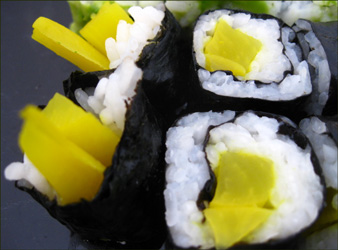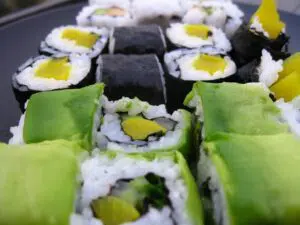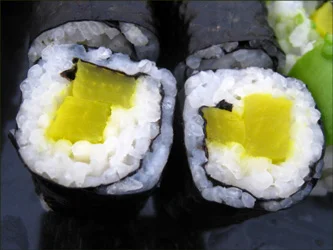Oshinko
Oshinko (also “Takuan”) is a Japanese pickled radish. It has a strong flavor, and so can serve as a single filling in a small (hoso) maki roll, or as an addition to other fillings in Foto-maki, or Ura-maki rolls. Since pickled, the Oshinko can be stored for long periods in the fridge, even after opening – so it’s a relatively more convenient to handle than most sushi ingredients. Not only for sushi by the way, Oshinko works well in salads and other cold dishes. Oshinko is one of those wonderful things that you might happen to see on the menu of your local sushi place without knowing what it is. Well, we’re here to help! Read on for everything that you need to know.

What is Oshinko?
Oshinko is, at the root of it, a type of Japanese pickle. It’s usually made from a daikon radish, which looks a lot like a big, yellow carrot. Of course, other veggies can be used and a similar flavor can be achieved, though it’s typically oshinko.

The word ‘oshinko’ means ‘fragrant dish’, which is really in reference to the process of pickling. Pickling nearly anything will result in a powerful aroma, hence the name. This means that you could pick up a jar labeled ‘oshinko’, and the veg within might not be a daikon radish. As a rule of thumb: if the food is yellow, it’s very likely to be a radish in this case.
The pickled radish dish has a fairly standard taste – a combination of heady salt and potent pickling vinegar. That’s what you might expect from this recipe, and for good reason – the dish is pickled, and the food certainly has that taste to it.

Flavor Notes
Daikon is, of course, pickled radish. The recipe is something that’s typically referred to as a quick pickle – making use of salt and vinegar to quickly brine and pickle something. Daikon radishes are quite mild themselves (a cross between a carrot and a radish) which means that the pickled flavor comes through very strongly.
The best comparison that we’ve really got for the flavor is homemade sauerkraut: quite salty, as well as being notably acidic. Because you’re only eating a small amount, the flavor isn’t overwhelming, instead being well-paired with the seaweed and sushi rice. Oshinko has a flavor that’s quite typical of Japanese food. Therefore, if you’re a fan of Japanese food in general, then you’ll likely enjoy oshinko and oshinko maki rolls too.

Culinary Use Today
Generally speaking, oshinko is used in vegetarian versions of classic sushi recipes. The pickle is typically rolled with rice and seaweed to make sushi, which is then typically portioned into bite-sized pieces.

Because of the potent flavor that oshinko has, it is usually used sparingly and alone in sushi rolls. The rice and the seaweed serve to mellow out the overall flavor quite a lot, leading to a dish that has a strong flavor used sparingly.
A good comparison for this ingredient could be gochujang, the Korean hot chili paste. It has a very strong flavor on its own and therefore isn’t used as a condiment, but when used in small portions, it boosts a ramen dish out of this world.

Where can I get Oshinko?
Oshinko, as most sushi ingredients, can be purchased at Asian markets and food stores. Can also be found in online stores – see links below for Amazon:



Rate this recipe
9 People Rated This Recipe
Average Rating
No comments yet.